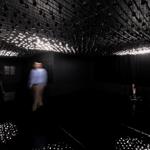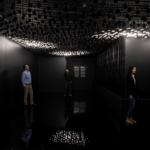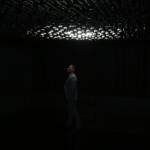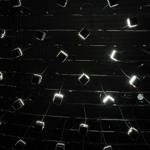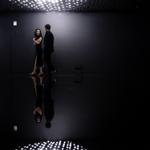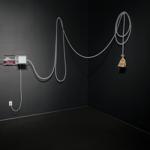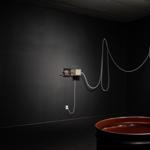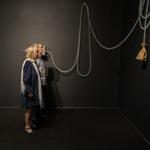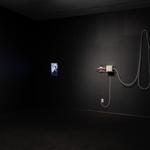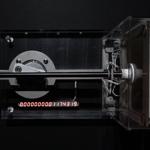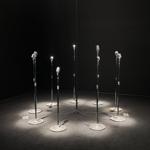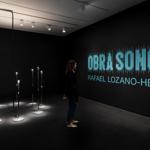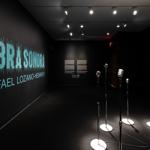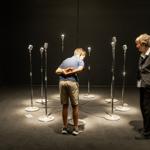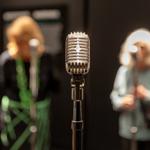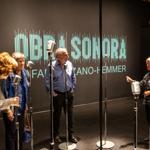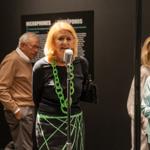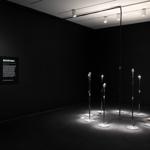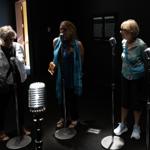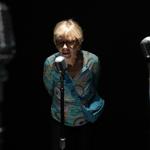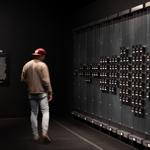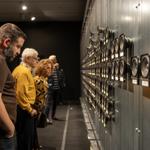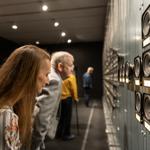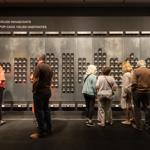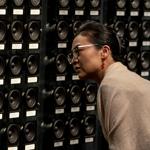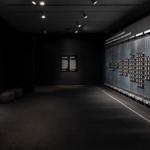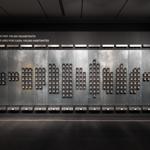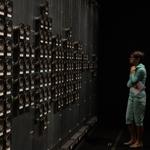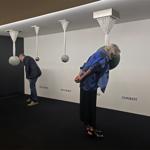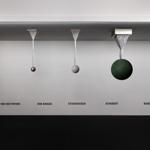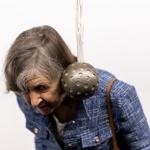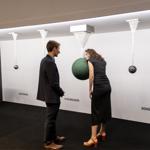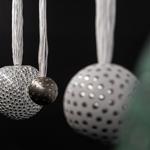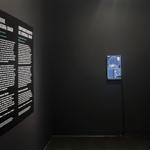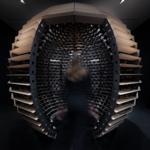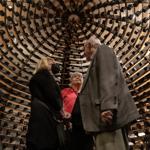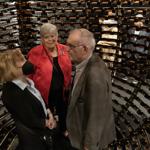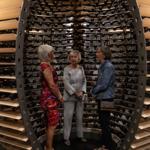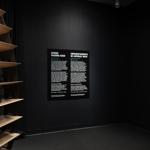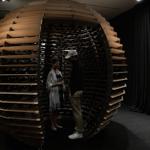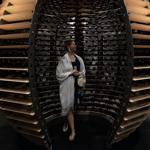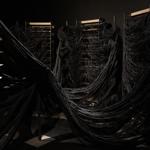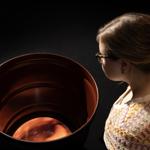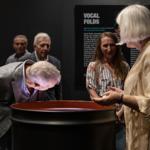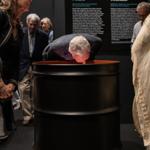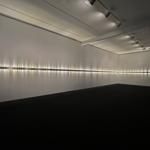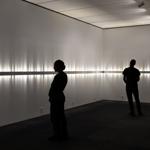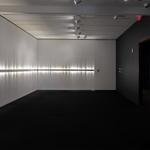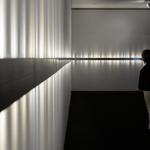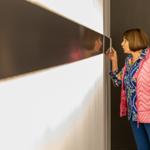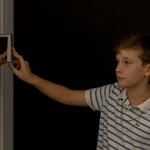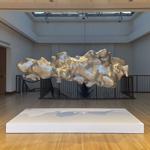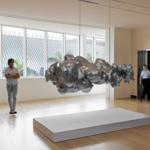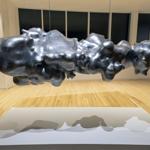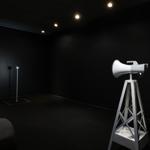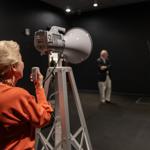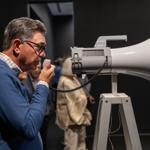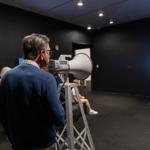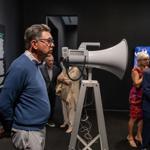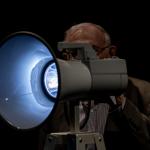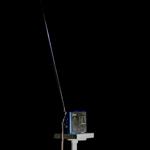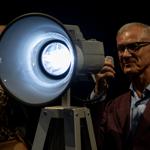Rafael Lozano-Hemmer: Obra Sonora
Naples, Florida, United States
December 7th, 2024 - June 15th, 2025
OBRA SONORA—Sound Work in Spanish—comprises 15 artworks by Rafael Lozano-Hemmer that engage and experiment with sound as their primary medium. Together, these pieces intone various histories and traditions of auditory experience and sonic practices, ranging from multi-channel audio environments with thousands of speakers—what the artist describes as “speakers as pixels”—to embodied architectures for collective listening, from sound-objects to endoscopic explorations of the very anatomy of vocal expression. This range of approaches to sonority is matched by the exhibition’s changing sensorial atmospheres. Within the fluctuating terrain of OBRA SONORA, one work might invoke an interactive and intimate experience, while the next will loom with dense layers of noise; one might offer a liberating view of the potential change a single speaking voice might spark, while the next will showcase the bellicose marches that make up most of the world's national anthems. As museum visitors circulate the exhibition, they are confronted with and compelled to consider the shifting politics of the voice, of noise, and of the cultural contexts where we encounter and listen to one another.
OBRA SONORA begins with a suspended cloud-like sculpture that represents the exact shape of the air exhaled during speech. "Listen to the World, Volute 2" (2024) was made with a laser-tomography scan of the turbulent air ejected by a single human voice as it uttered the sentence: “Listen to the World.” An homage to the influential composer R. Murray Schafer, who revolutionized the arts with his practice of acoustic ecology and his concept of the “soundscape,” the sculpture renders the spoken word tangible. At the same time, the piece intones a vastly different tradition, that of the “speech-scroll” (also called a speech-bubble, banderole, phylactery or volute), an illustrative device similar to those used by Olmec, Mayan, Mixtec and other Pre-Columbian cultures to represent spoken words or song. The piece is on loan from the Jumex Collection in Mexico City.
“Microphones” (2008) is an interactive installation featuring several 1939-vintage Shure microphones, placed on mic stands around the exhibition room at different heights. Inside each modified microphone's head is a tiny loudspeaker and circuit board connected to a network of hidden control computers. When a public member speaks into a microphone, it records their voice and immediately plays back the voice of a previous participant, as an echo from the past. The result is surprising because the sound comes directly from the microphone, which “speaks back,” a memory of what has already been said. Ultimately, the public's participation is what generates the piece's content.
“Voz Alta” (Loud Voice) (2008) is a documentary video and prototype of a public artwork commissioned by UNAM University to commemorate the 40th anniversary of the student massacre in Tlatelolco, Mexico, that took place on October 2, 1968. In the piece, participants spoke freely into a megaphone placed on the “Plaza de las Tres Culturas,” where the massacre occurred, and as the megaphone amplified their voice, four powerful searchlights beamed the voice as a sequence of flashes onto a series of governmental and cultural spaces in Mexico City. Simultaneously, the participation was livecast by Radio UNAM station, so that anyone tuning to 96.1 FM could listen live to what the lights were saying. Thousands of people participated in the project without censorship or moderation and, at times when no one spoke through the megaphone, archival recordings of students, poets and activists documenting the memory of the massacre resonated throughout these public and radio spaces. The piece is on loan from the Cisneros Fontanals Collection.
The “Sphere Packing” series (2013) deploys a wildly different iteration of the sonic archive and cultural memory. Here, Lozano-Hemmer has designed a series of 3D-printed suspended pieces with tiny embedded loudspeakers, each of which plays back a different composition from a specific composer, so that a sphere concentrates their life's entire musical production. The series takes its inspiration from American composer Charles Ives’ practice of simultaneity as a compositional tool. The spheres, suspended from clusters of speaker wire, vary in size; Schubert’s sphere contains 998 speakers, while Monteverdi’s only contains 17. As viewers approach the spheres, their indiscriminate hum gives way to the faint sound of a specific composition emanating from the nearest speaker. This piece stages a complex encounter between qualitative and quantitative conceptions of musicality. The act of quantifying a composer’s output gives way to many new qualitative dimensions of listening, which must now navigate intricate textures of quietly clashing rhythms, tones, and expressions.
“Sphere Packing: Bach” (2018) is the culmination of the series, as we encounter a 10-foot diameter sphere made out of wood and aluminum that supports an array of 1,128 loudspeakers, each of which plays a different composition by Johann Sebastian Bach. The piece is designed to concentrate Bach’s entire musical production in a dense multi-channel structure that visitors can enter. At any given point, all compositions play-back simultaneously creating a polyvocal and complex sound environment focused in the center of the sphere; from time to time the speakers are gradually silenced in waves to highlight one speaker playing a single composition. The piece is on loan from Borusan Contemporary in Istanbul.
“Pan-Anthem” (2014) intones a similar clash of compositions. In this work, Lozano-Hemmer arranges a set of movable, magnetic speakers loaded with anthems from every nation that are precisely arranged to visualize a set of national statistics: whether by population, GDP, number of women in parliament, land mass, or year of independence, to name a few possible arrangements. For example, when the work is configured to show the spread of national military spending per capita, on the far left of the wall, the public can hear the anthems of countries without military forces, like Costa Rica, Iceland and Andorra. As they walk to the right, they are able to hear Mexico at 2 feet away, then Turkey at 5 feet away, the Russian anthem plays at 7.5 feet, UK at 15.5 feet, Saudi Arabia at 24 feet, Israel at 28.5 feet, and finally the United States’ Star Spangled Banner plays by itself at the far right of the room, 30 feet away. As a visitor approaches a set of speakers, they start playing automatically, creating a positional panoramic playback of anthems associated with the specific metrics.
The following room contains “Field Atmosphonia” (2020), a sound and light environment featuring 3,000 audio channels playing field recordings on custom-made speakers with LED lights. The project is a soundscape that comes in waves of complex polyphonies that emerge with interaction. The piece is presented in a large room, with the recordings changing typology gradually along the field of speakers. Samples include wind, water, fire, ice, over 200 types of insects, over 300 species of birds, bells, metronomes, and bombs. This installation is part of the series of pieces investigating the perception of thousands of simultaneous sounds, each playing in a different dedicated loudspeaker, what Lozano-Hemmer calls “speaker as pixel.” A pixel is a point of light varying in intensity and spectral frequency. Coordinated with its neighbors, the perception of pixels gives rise to images. The question is: If we have thousands of sound sources in an array, can we see a new perceptible complexity emerging beyond the expected cacophony?
“Last Breath” (2012) is an installation designed to store and circulate the breath of American avant-garde composer and accordionist Pauline Oliveros forever. The piece consists of a small, brown paper bag which inflates and deflates automatically thanks to motorized bellows similar to those found in artificial respirators in hospitals. The apparatus hangs on a wall and is activated 10,000 times a day, emulating the typical respiratory frequency for an adult at rest, including 158 sighs. Each stroke of the machine advances a digital counter that beeps. Oliveros' breath circulates between the bellows and the paper bag through a ribbed transparent plastic tube that emits a faint and hypnotic low sound, while the brown paper bag makes a rhythmic crushing sound as it inflates and deflates. As a biometric portrait currently in the collection of SFMOMA, the piece is a homage to the great composer who passed away in 2016.
In “Vocal Folds” (2019) a custom circular display is housed at the bottom of an oil drum and plays laryngoscopic videos. Five English actors read aloud during an endoscopic filming: the camera introduced into their nose, down their larynx, reaching their vocal folds and cords. The words read aloud were fragments from Charles Babbage’s “Ninth Bridgewater Treatise” (1837), in which Babbage posits that all words ever spoken remain in the atmosphere, as small particles emitted from a speaker’s mouth into the air.
In “Voice Array” (2011), Lozano-Hemmer articulates his ongoing explorations of biometric portraiture, participatory systems, modes of collection, and cacophony. The piece, a long, linear array of LED lights embedded in a metal strip that circumvents a room, invites visitors to record a sample of their voice by pressing a button and speaking into a small intercom. The recorded voice then lights up a succession of LED lights that travel around the room, surrounding the speaker. As the lights travel, the cumulative murmur of the 288 voices stored by the piece’s memory erupts, until finally, for the last time, one individual recording plays before it is pushed out of the system by the new voice. In this space, the encounter and uncertain relation between the individual and the collective, the infinite and the finite echoes onward.
Finally, "Shadow Tuner" (2024) is a 32-inch-diameter spherical display that shows an animated Earth rotating slowly. A custom-made computer surveillance system detects the public’s presence, projecting their live shadow on the surface of the miniature Earth. As the shadows overlap different cities, they automatically tune live radio stations from a database of over 12,000 geolocated streams, creating a global tuning device. The piece was originally commissioned by the Thoma Foundation.
Featuring two world premieres and three North American premieres, OBRA SONORA is Lozano-Hemmer's most ambitious exhibition focused on exploring the materiality of sound as a medium of expression and image-making.
-Michael Nardone
OBRA SONORA begins with a suspended cloud-like sculpture that represents the exact shape of the air exhaled during speech. "Listen to the World, Volute 2" (2024) was made with a laser-tomography scan of the turbulent air ejected by a single human voice as it uttered the sentence: “Listen to the World.” An homage to the influential composer R. Murray Schafer, who revolutionized the arts with his practice of acoustic ecology and his concept of the “soundscape,” the sculpture renders the spoken word tangible. At the same time, the piece intones a vastly different tradition, that of the “speech-scroll” (also called a speech-bubble, banderole, phylactery or volute), an illustrative device similar to those used by Olmec, Mayan, Mixtec and other Pre-Columbian cultures to represent spoken words or song. The piece is on loan from the Jumex Collection in Mexico City.
“Microphones” (2008) is an interactive installation featuring several 1939-vintage Shure microphones, placed on mic stands around the exhibition room at different heights. Inside each modified microphone's head is a tiny loudspeaker and circuit board connected to a network of hidden control computers. When a public member speaks into a microphone, it records their voice and immediately plays back the voice of a previous participant, as an echo from the past. The result is surprising because the sound comes directly from the microphone, which “speaks back,” a memory of what has already been said. Ultimately, the public's participation is what generates the piece's content.
“Voz Alta” (Loud Voice) (2008) is a documentary video and prototype of a public artwork commissioned by UNAM University to commemorate the 40th anniversary of the student massacre in Tlatelolco, Mexico, that took place on October 2, 1968. In the piece, participants spoke freely into a megaphone placed on the “Plaza de las Tres Culturas,” where the massacre occurred, and as the megaphone amplified their voice, four powerful searchlights beamed the voice as a sequence of flashes onto a series of governmental and cultural spaces in Mexico City. Simultaneously, the participation was livecast by Radio UNAM station, so that anyone tuning to 96.1 FM could listen live to what the lights were saying. Thousands of people participated in the project without censorship or moderation and, at times when no one spoke through the megaphone, archival recordings of students, poets and activists documenting the memory of the massacre resonated throughout these public and radio spaces. The piece is on loan from the Cisneros Fontanals Collection.
The “Sphere Packing” series (2013) deploys a wildly different iteration of the sonic archive and cultural memory. Here, Lozano-Hemmer has designed a series of 3D-printed suspended pieces with tiny embedded loudspeakers, each of which plays back a different composition from a specific composer, so that a sphere concentrates their life's entire musical production. The series takes its inspiration from American composer Charles Ives’ practice of simultaneity as a compositional tool. The spheres, suspended from clusters of speaker wire, vary in size; Schubert’s sphere contains 998 speakers, while Monteverdi’s only contains 17. As viewers approach the spheres, their indiscriminate hum gives way to the faint sound of a specific composition emanating from the nearest speaker. This piece stages a complex encounter between qualitative and quantitative conceptions of musicality. The act of quantifying a composer’s output gives way to many new qualitative dimensions of listening, which must now navigate intricate textures of quietly clashing rhythms, tones, and expressions.
“Sphere Packing: Bach” (2018) is the culmination of the series, as we encounter a 10-foot diameter sphere made out of wood and aluminum that supports an array of 1,128 loudspeakers, each of which plays a different composition by Johann Sebastian Bach. The piece is designed to concentrate Bach’s entire musical production in a dense multi-channel structure that visitors can enter. At any given point, all compositions play-back simultaneously creating a polyvocal and complex sound environment focused in the center of the sphere; from time to time the speakers are gradually silenced in waves to highlight one speaker playing a single composition. The piece is on loan from Borusan Contemporary in Istanbul.
“Pan-Anthem” (2014) intones a similar clash of compositions. In this work, Lozano-Hemmer arranges a set of movable, magnetic speakers loaded with anthems from every nation that are precisely arranged to visualize a set of national statistics: whether by population, GDP, number of women in parliament, land mass, or year of independence, to name a few possible arrangements. For example, when the work is configured to show the spread of national military spending per capita, on the far left of the wall, the public can hear the anthems of countries without military forces, like Costa Rica, Iceland and Andorra. As they walk to the right, they are able to hear Mexico at 2 feet away, then Turkey at 5 feet away, the Russian anthem plays at 7.5 feet, UK at 15.5 feet, Saudi Arabia at 24 feet, Israel at 28.5 feet, and finally the United States’ Star Spangled Banner plays by itself at the far right of the room, 30 feet away. As a visitor approaches a set of speakers, they start playing automatically, creating a positional panoramic playback of anthems associated with the specific metrics.
The following room contains “Field Atmosphonia” (2020), a sound and light environment featuring 3,000 audio channels playing field recordings on custom-made speakers with LED lights. The project is a soundscape that comes in waves of complex polyphonies that emerge with interaction. The piece is presented in a large room, with the recordings changing typology gradually along the field of speakers. Samples include wind, water, fire, ice, over 200 types of insects, over 300 species of birds, bells, metronomes, and bombs. This installation is part of the series of pieces investigating the perception of thousands of simultaneous sounds, each playing in a different dedicated loudspeaker, what Lozano-Hemmer calls “speaker as pixel.” A pixel is a point of light varying in intensity and spectral frequency. Coordinated with its neighbors, the perception of pixels gives rise to images. The question is: If we have thousands of sound sources in an array, can we see a new perceptible complexity emerging beyond the expected cacophony?
“Last Breath” (2012) is an installation designed to store and circulate the breath of American avant-garde composer and accordionist Pauline Oliveros forever. The piece consists of a small, brown paper bag which inflates and deflates automatically thanks to motorized bellows similar to those found in artificial respirators in hospitals. The apparatus hangs on a wall and is activated 10,000 times a day, emulating the typical respiratory frequency for an adult at rest, including 158 sighs. Each stroke of the machine advances a digital counter that beeps. Oliveros' breath circulates between the bellows and the paper bag through a ribbed transparent plastic tube that emits a faint and hypnotic low sound, while the brown paper bag makes a rhythmic crushing sound as it inflates and deflates. As a biometric portrait currently in the collection of SFMOMA, the piece is a homage to the great composer who passed away in 2016.
In “Vocal Folds” (2019) a custom circular display is housed at the bottom of an oil drum and plays laryngoscopic videos. Five English actors read aloud during an endoscopic filming: the camera introduced into their nose, down their larynx, reaching their vocal folds and cords. The words read aloud were fragments from Charles Babbage’s “Ninth Bridgewater Treatise” (1837), in which Babbage posits that all words ever spoken remain in the atmosphere, as small particles emitted from a speaker’s mouth into the air.
In “Voice Array” (2011), Lozano-Hemmer articulates his ongoing explorations of biometric portraiture, participatory systems, modes of collection, and cacophony. The piece, a long, linear array of LED lights embedded in a metal strip that circumvents a room, invites visitors to record a sample of their voice by pressing a button and speaking into a small intercom. The recorded voice then lights up a succession of LED lights that travel around the room, surrounding the speaker. As the lights travel, the cumulative murmur of the 288 voices stored by the piece’s memory erupts, until finally, for the last time, one individual recording plays before it is pushed out of the system by the new voice. In this space, the encounter and uncertain relation between the individual and the collective, the infinite and the finite echoes onward.
Finally, "Shadow Tuner" (2024) is a 32-inch-diameter spherical display that shows an animated Earth rotating slowly. A custom-made computer surveillance system detects the public’s presence, projecting their live shadow on the surface of the miniature Earth. As the shadows overlap different cities, they automatically tune live radio stations from a database of over 12,000 geolocated streams, creating a global tuning device. The piece was originally commissioned by the Thoma Foundation.
Featuring two world premieres and three North American premieres, OBRA SONORA is Lozano-Hemmer's most ambitious exhibition focused on exploring the materiality of sound as a medium of expression and image-making.
-Michael Nardone
General info
Show type:
Museum
Floor space:
Total area coverage of 573 square metres
Attendance:
23236
Included projects:
Credits:
- Antimodular Production: Najeeba Ahmed, Tim Belliveau, Karine Charbonneau, Lauria Clarke, Agnès Dakroub, Hugo Daoust, Emma Dickson, Emily Green, Alison Hedley, Steven Hoffart, Jean Madore, Luis Morales, Michael Nardone, Veronica Rha, Gabriel Rizzotti, David Robert, Stephan Schulz, Jade Séguéla, Daniela Silva, Benoit Soucy, William Sutton, Guillaume Tremblay, Matthieu Vanier, Saraid Wilson, Saralin Zassman.
- Libby Harrington and Production Team Alex, Mauro, Grayson, Alejandro, Dan and Dan
- Casandra, Tim, Christine, Alice, Andrea, Tamara
Bibliography
 Nardone, Michael . "An Atmospheric Commons." Espace Art Actuel. Montréal, Québec, Canada. (english and français) (Magazines)
Nardone, Michael . "An Atmospheric Commons." Espace Art Actuel. Montréal, Québec, Canada. (english and français) (Magazines)
Photo Library (click to expand)
